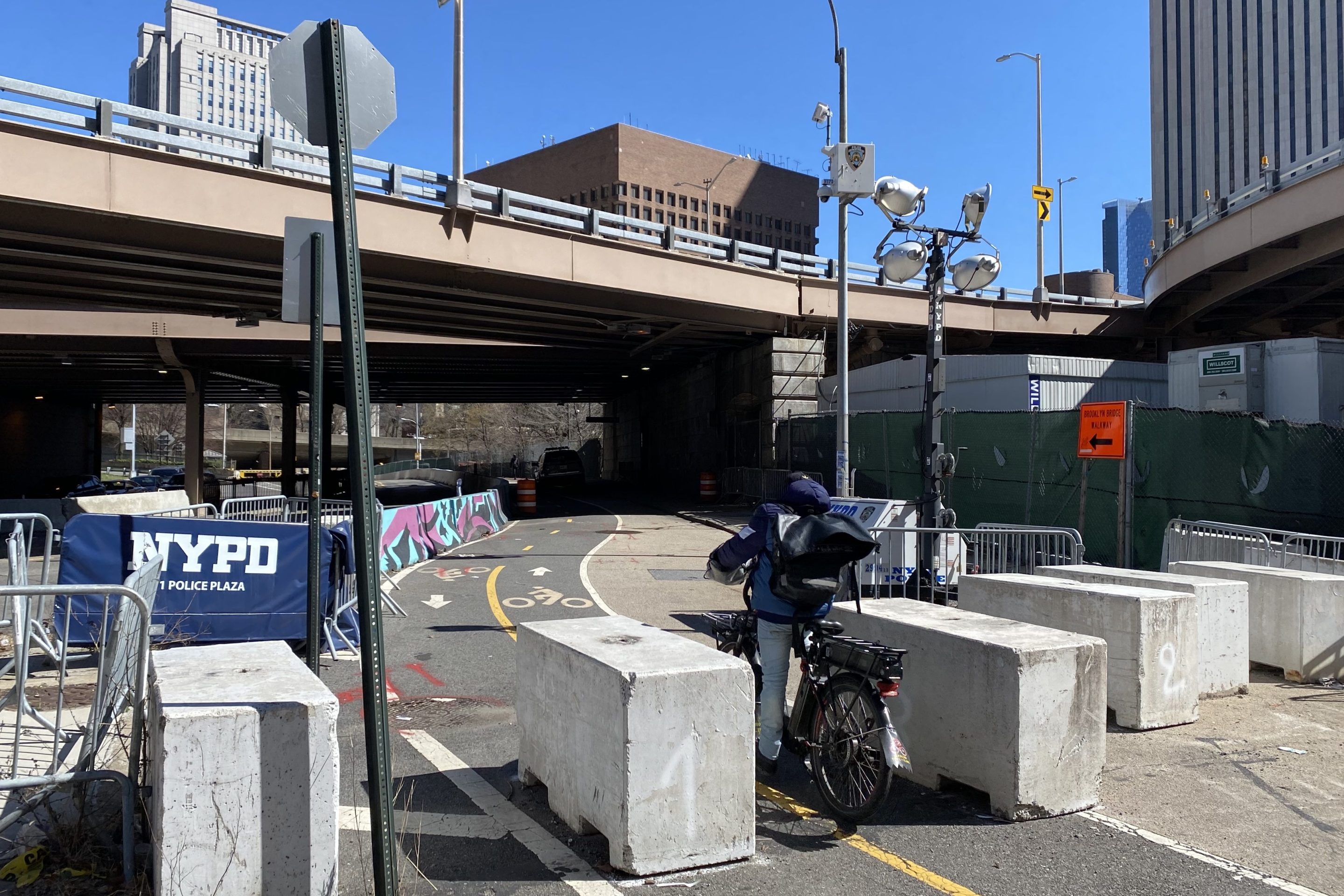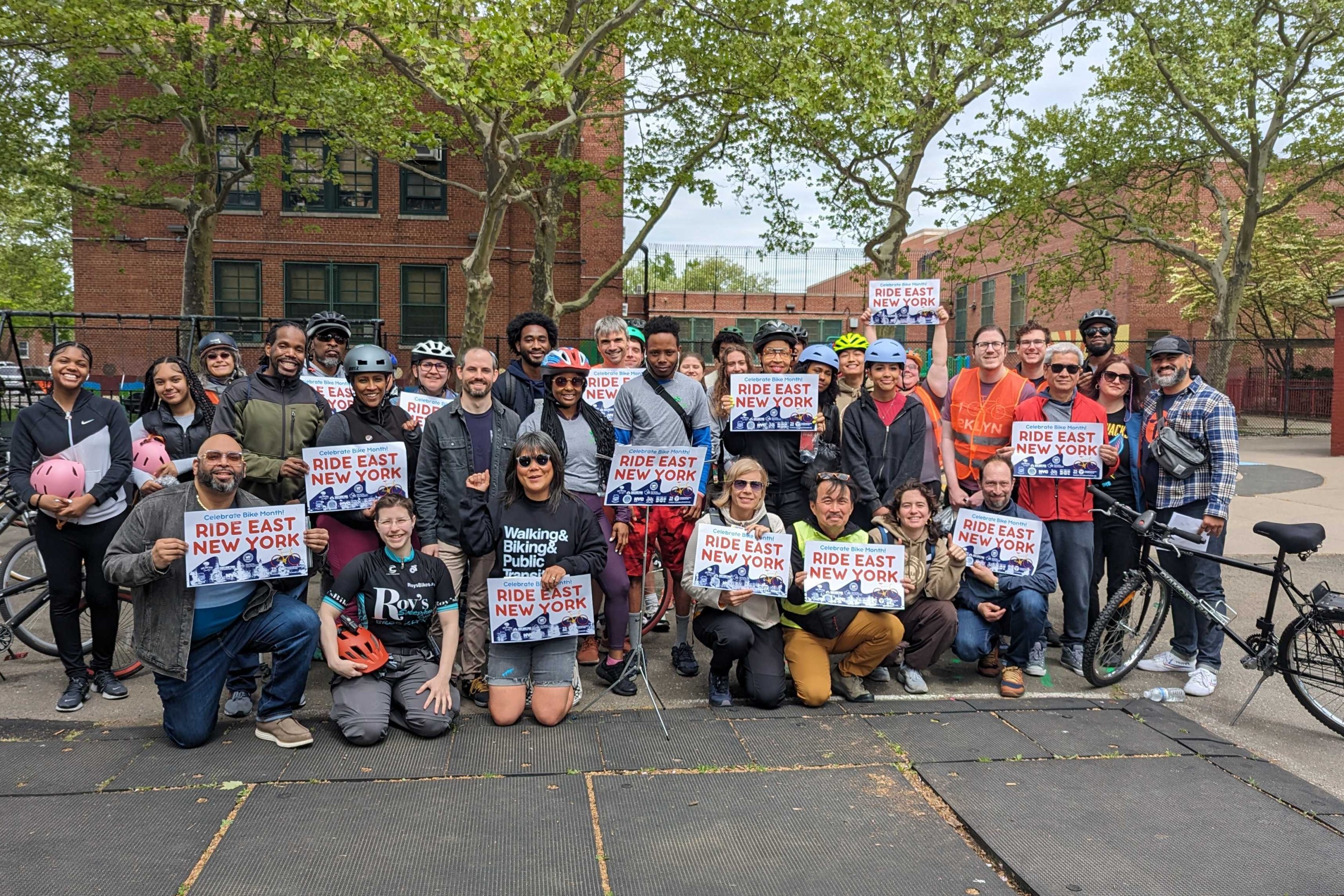Op-Ed: Here’s a Better, Cheaper and Safer 79th Street Rotunda Plan
9:38 AM EST on January 2, 2019
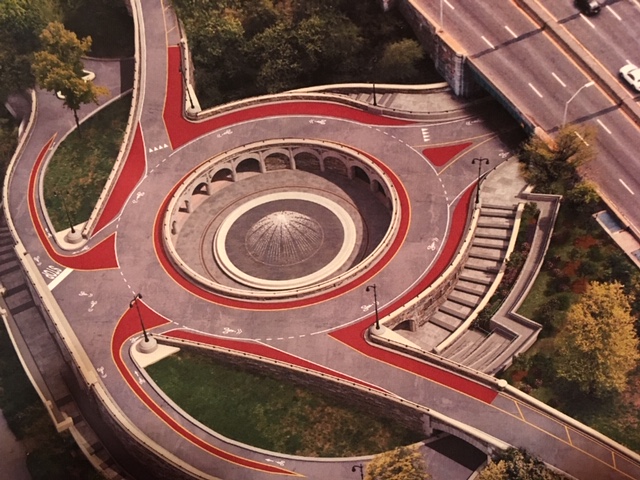
DOT’s redesign of the 79th Street rotunda omits protection for people attempting to access the country’s most popular bike path. Image: DOT
The city Department of Transportation's $150- to $200-million plan to rebuild the roundabout at 79th Street on the Upper West Side would make a dangerous piece of roadway worse for vulnerable road users.
This western end of 79th Street is a crucial access point to the Hudson River Greenway, the busiest bike path in the U.S. For decades, cyclists have been forced to mix it up with cars entering and exiting the West Side Highway. The rotunda is a scary place for cyclists and most cyclists are too intimidated to even risk maneuvering in the motorized traffic flow.
The rotunda is a multi-level Robert Moses era structure that contains an underground parking garage and a plaza level with a restaurant and outdoor seating capped with a traffic circle which serves as both an exit from and an entrance to the West Side Highway. Along the outside of the structure are stairs on both sides which allow pedestrians to access the plaza safely, separated from traffic. In addition, the rotunda is the turnaround spot for the M79 bus.
Last renovated in the 1975, the 83-year-old rotunda is showing its age. For decades, the road surface of the roundabout has been pitted with potholes and in recent years the gouges in the road surface have been getting worse.
DOT presented its construction plans to Community Board 7 in October, and board members said the agency failed to address the issue of unsafe conditions for cyclists. CB7 asked DOT to revise the plan and come back with something better.
But when DOT returned in December, the agency offered no changes to the unsafe bicycling conditions in the plan. (Full disclosure: I was at the Dec. 17 meeting, and I was disappointed at DOT’s indifference to cyclist safety and the interests of the community in general.)
For example, DOT announced that for the three to four years of the construction, workers will occupy the two ballfields on W. 74th and 75th streets that are heavily used by Upper West Side kids — partly for staging, but partly, apparently, for parking for the construction workers. Members of CB7 are still trying to get confirmation of this statement.
It was clear that the DOT engineers knew that their proposal was unsafe. They said several times that the Manual on Uniform Traffic Control Devices didn’t allow bikes in traffic circles. But when faced with a known unsafe condition, the DOT staff and engineers seemed indifferent — in fact, making a big deal only about the part of the plan that calls for adding a railing to the top of the wall around the traffic circle. Such an improvement would bring the wall up to code. Never mind that no one has ever fallen over this wall — to these engineers, if the wall met the code, it was “safe.” The engineers seemed to content to live in their parallel reality of irrelevant, outdated engineering standards while ignoring the real life safety concerns of the community board and members of the neighborhood.
I have been biking through the roundabout on a nearly daily basis for most of the past 20 years. I have experienced drivers honking and yelling at my children for having the temerity to bike to a soccer game in the park. I have had impatient drivers blindly pass another car only to be surprised to find me in the roadway. I have learned that by staying to the edge of the circle, I am generally able to stay out of the way of the aggressive drivers. When exiting the park, I pay attention to where a driver entered the traffic circle, so I can figure out who is going to W. 79th Street and who is going to accelerate onto the highway. I have even come to appreciate the field of potholes which act as a form of natural traffic calming.
The traffic patterns in the DOT proposal would make things much worse. Instead of taking advantage of the full 31-foot width of the traffic circle to separate bikes as much as possible from cars, DOT’s proposal would occupy nearly half of the road width with a red high friction surface which would force the bikes and cars into one lane. I can tell you from personal experience that cars don’t like being stuck behind bikes and will frequently act impatiently and endanger the cyclists.
A quick Google search easily reveals the best practices for designing safe bike infrastructure at roundabouts. For those interested in reading more, I recommend this clip. Part of what you will learn is that the key to designing safe traffic circles is removing the conflicts. Traffic circles are inherently complicated and unsafe. The key is design bike infrastructure that avoids these conflicts.
After the disappointing CB7 meeting, I went home and realized that it would be easy to build bike connections around the rotunda that completely avoided the traffic circle. The original Robert Moses era design has these sorts of connections for pedestrians. All that is necessary is to build a parallel set of connections for cyclists. I have drawn where this bike connection would go in the image below.
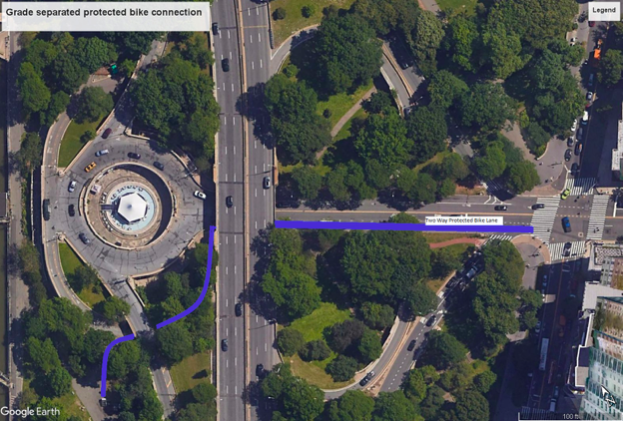

The proposed grade-separated bike connection runs into what seems like a solid wall. But on closer inspection this wall is fairly thin and covers an existing tunnel under the highway entrance ramp. This tunnel is currently used as an entrance to the underground parking garage. The garage entrance is extra wide and easily could accommodate a bike path next to the car access. This garage entrance is extremely low traffic. In thousand of trips by this entrance, I have only seen a car entering a handful of times.
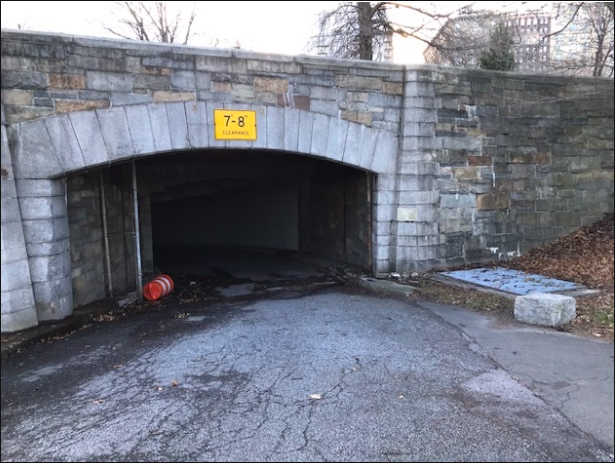
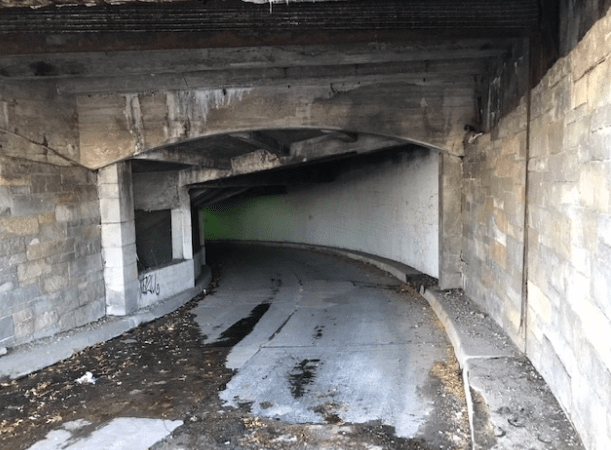
The extra costs of building this separated bike facility would be small compared to the rest of the project. DOT is already proposing to install a handicapped access ramp along a path right next to where the bike lane would go. I suspect that the pedestrian ramp and the bike path could be combined in this area. There would be an extra cost of punching a hole in the wall, but since the whole structure is being rebuilt, this extra cost should not be too much.
In order to get bike traffic from Riverside Drive to the rotunda, a two-way protected bike lane would need to be installed along the south side of 79th Street. Currently, the two eastbound lanes on 79th Street between the rotunda and Riverside Drive are fed by just one lane from the traffic circle, so removing one lane of space from automobiles and giving that to bikes would not create an issue. The intersection of 79th and Riverside Drive would be a bit more complicated as another exit from the Henry Hudson Parkway feeds into this intersection. This part of 79th and Riverside is currently quite dangerous and hostile to pedestrians. Impatient drivers coming off the highway frequently run red lights, so adding the two-way protected bike lane would prove an opportunity to redesign and fix a dangerous intersection that is also a major entrance to Riverside Park.
The DOT design proposal also has issues with pedestrian access to the rotunda. DOT did not make available a digital copy of its presentation, but from what I saw, the city is proposing to eliminate the pedestrian ramp at the north side of the rotunda. Currently, a steep wooden ramp has been laid on to top of the stairs allowing for parents to get strollers to the rotunda. This ramp is probably too steep to be ADA compliant, but many thousands of parents have been successfully using this ramp for years.
By eliminating this ramp from its design, DOT would be creating a situation where many parents who pushed their strollers a fair distance from Riverside all the way to the rotunda would be forced to turn around and head all the way back to Riverside Drive to cross the street before being able to access the rotunda. In addition, for many parents who have no problems with the current incline of the ramp, using the ADA-compliant ramp on the south side of the rotunda would be less appealing. The ADA ramp with all of its extra twists and turns would make for a longer, more unpleasant climb up from the plaza; and for parents looking to head north, the loss of the north side ramp would force them to cross 79th Street.
The decisions that DOT makes regarding the reconstruction of the 79th Street Rotunda will impact the Upper West Side for the next five decades. Upper West Siders aspire to be able to bike safely to Riverside Park with their kids. Robert Moses didn’t think that bikes had any place in New York. In the last 80 years, we have learned that Robert Moses was wrong, and biking is good for cities. DOT should not sentence Upper West Siders to another five decades of unsafe biking conditions. The proposed plan shows just how easy building safe biking infrastructure can be.
Mark Gorton is publisher of Streetsblog.
Stay in touch
Sign up for our free newsletter
More from Streetsblog New York City
City Considers Fixes for Another Ridiculously Slow Cross-Bronx Bus
Potential bus improvements are on the table for the Bronx's Tremont Avenue, but the Adams administration's failures on nearby Fordham Road loom large.
DOT Unveils First Step for Park Row Redesign
The city hopes to make Park Row more appealing to residents and visitors. But the real work is years off.
Monday’s Headlines: East New York’s New Bikes Lanes Reduced Crashes Edition
Initial results show East New York's protected bike lanes made Cozine and Wortman avenues safer. Plus more news.
Stockholm Leader’s Message to NYC: ‘Congestion Pricing Just Works’
"In Stockholm, people really thought that congestion pricing would be the end of the world, the city will come to a standstill, no one would be able to get to work anymore and all the theaters and shops would just go bankrupt. None of that happened."
Friday’s Headlines: Trump Trial Trumps Safety Edition
Is anyone going to bother to fix the dangerous mess on the streets and plazas around the Trump trial? Plus more news.

